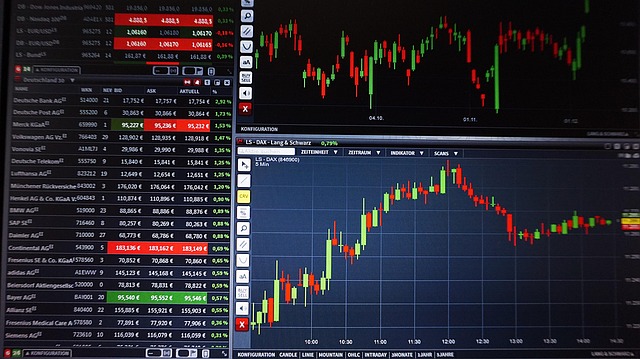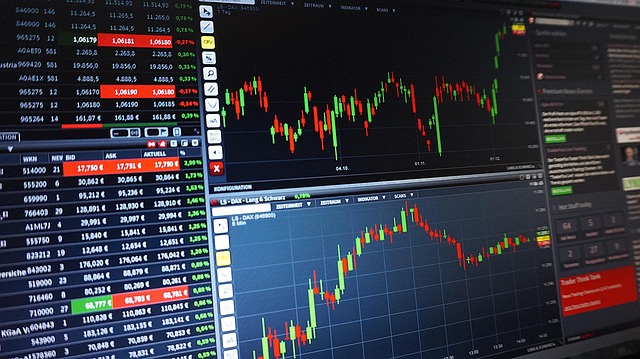Binance Trading Course: Complete Practical Learning Guide
Author: Jameson Richman Expert
Published On: 2025-10-27
Prepared by Jameson Richman and our team of experts with over a decade of experience in cryptocurrency and digital asset analysis. Learn more about us.
Summary: This comprehensive binance trading course guide explains what to expect from a top-tier course, how to choose one, a recommended 8-week curriculum, practical trading strategies, tools for practice, risk management, and how to turn learning into consistent results. Whether you’re a beginner or an intermediate crypto trader, this article gives step-by-step guidance, examples, and vetted resources to master Binance trading safely and effectively.

Why take a Binance trading course?
Binance is one of the largest cryptocurrency exchanges globally, offering spot, margin, futures, options, staking, lending, and more. A structured Binance trading course helps you learn platform mechanics, market structure, charting, and risk controls specific to crypto markets — areas standard stock-trading courses don’t always cover. Good courses also focus on psychology, position sizing, and building repeatable strategies so you avoid common trader mistakes.
Key benefits
- Platform familiarity: Streamlined onboarding, order types, interface navigation, and API access.
- Strategy education: Scalping, swing trading, grid and arbitrage strategies adapted to crypto markets.
- Hands‑on practice: Guided labs, paper trading, and real-trade examples to fast-track learning.
- Risk management: Position sizing, stop-loss rules, and portfolio diversification tailored to volatile assets.
- Community & mentorship: Peer feedback, live trading rooms, and Q&A sessions that shorten the learning curve.
What a high-quality Binance trading course covers
Top courses break content into progressive modules. A robust binance trading course should include:
1. Account setup and security
- KYC and compliance expectations.
- Two-factor authentication (2FA), anti-phishing codes, and cold storage basics.
- API keys: creating, permissions, and safe usage.
2. Binance platform walkthrough
- Spot trading: placing limit, market, and stop-limit orders.
- Margin trading: leverage basics, margin ratio, and liquidation mechanics.
- Futures and derivatives: perpetual contracts, funding rates, and cross vs isolated margin.
- Earn products: staking, savings, liquidity farming, and launchpad.
3. Market fundamentals and on‑chain basics
- Understanding tokenomics and circulating supply.
- On-chain signals: active addresses, transfer volumes, and exchange flows.
- Macro drivers: macro liquidity, regulatory news, and market cycles.
4. Technical analysis (TA) tailored to crypto
- Price action, support/resistance, and trend structure.
- Indicators: EMA, MACD, RSI, Bollinger Bands, VWAP.
- Volume analysis and order flow basics for entries/exits.
5. Trading strategies and templates
- Scalping playbook with exact entry/exit rules.
- Swing trades: setups, stops, and trade management.
- Grid trading, dollar-cost averaging (DCA), and algorithmic approaches.
6. Risk management and psychology
- Position sizing formulas and portfolio-level risk limits.
- Stop placement techniques and trade journaling.
- Emotional control strategies and routine checklists.
7. Backtesting and automation
- Backtest frameworks, metrics (win rate, expectancy, max drawdown).
- Automated bots, basic scripting, and API usage.
How to choose the best Binance trading course
Not all courses are created equal. Use this checklist when evaluating options:
- Instructor credibility: Track record, verifiable trading results, and transparency about performance.
- Curriculum depth: Does the course cover both fundamentals and advanced topics, including risk management?
- Hands-on practice: Look for labs, demos, and assignments. Theory without practice is insufficient.
- Community & mentorship: Active community channels and access to mentors speed learning.
- Updates and relevancy: Crypto markets change—does the course update content regularly?
- Reviews & testimonials: Seek independent reviews, not just site testimonials.
- Refund policy: A clear refund policy reduces risk when buying a paid course.

Free vs paid Binance trading course — pros and cons
Free resources are a good starting point but often lack structure. Paid courses typically offer curated roadmaps, instructor access, and private communities. Consider a hybrid approach: begin with free materials and upgrade when you need mentorship, structured curriculum, or verified trading frameworks.
Sample 8-week practical Binance trading course curriculum
The following is a sample program designed to build real competence in eight weeks. Each week includes reading, practice exercises, and a short assessment.
Week 1 — Foundation & Security
- Objectives: Understand accounts, KYC, 2FA, and Binance UI.
- Practice: Register (use official link) and enable 2FA. Explore Spot and Convert features.
- Assessment: Securely create API keys and draft a personal security checklist.
Week 2 — Market Structure & Order Types
- Objectives: Master market/limit/stop-limit and OCO orders.
- Practice: Place simulated trades using testnet or small real trades with strict risk limits.
Week 3 — Technical Analysis Essentials
- Objectives: Learn support/resistance, trendlines, candlestick patterns.
- Practice: Mark charts on TradingView and document 10 trade ideas.
Week 4 — Indicators & Strategy Building
- Objectives: Study EMA crossovers, MACD divergences, RSI thresholds.
- Practice: Backtest a simple EMA crossover strategy on 3 coins.
Week 5 — Futures and Leverage
- Objectives: Understand leverage risks, funding rates, and liquidation mechanics.
- Practice: Use Binance Testnet Futures to place isolated-margin demo trades.
Week 6 — Risk Management & Trade Management
- Objectives: Build position-sizing rules, stop placement, and trailing stop techniques.
- Practice: Create a personal trading plan with max drawdown limits and daily risk caps.
Week 7 — Automation & Backtesting
- Objectives: Learn basic bot strategies, backtesting frameworks, and performance metrics.
- Practice: Backtest a grid or momentum bot; calculate expectancy and Sharpe ratio.
Week 8 — Live Trading & Review
- Objectives: Execute a 1–4 week live plan with small size and journal all trades.
- Assessment: Review journal, calculate win rate, average win/loss, and plan next steps.
Actionable trading strategies taught in a Binance course
The most practical courses teach repeatable, rule-based strategies. Here are five with short examples:
1. Trend-following swing trade
Setup: 20 EMA above 50 EMA on 4-hour chart + pullback to support. Entry: bullish candle close above pullback high. Stop: below recent swing low. Target: 2x risk or next resistance.
2. Scalping (low timeframe)
Setup: 1-minute to 5-minute momentum plays around major liquidity. Entry: break of consolidation with volume spike. Stop: tight, 0.2–0.5% (depending on asset volatility). Manage fees and slippage carefully.
3. Grid trading (range-bound markets)
Setup: Identify range boundaries. Place buy orders at regular intervals below current price and sell orders above. Grid width and number of levels determine risk and capital allocation. Good for sideways markets.
4. Futures directional strategy
Setup: Use funding-rate awareness. When funding is very positive, longs pay shorts — this can create short-term squeeze opportunities. Trade small size with tight stops to manage liquidation risk.
5. Dollar-Cost Averaging (DCA)
Setup: Regular purchases of a chosen coin at fixed intervals (e.g., weekly). Useful for long-term exposure with volatility smoothing.

Risk management — formulas and examples
Risk controls determine long-term survival. Use simple formulas:
- Position size = (Account equity × Risk per trade) / (Entry price − Stop price)
- Example: Account = $5,000, Risk per trade = 1% ($50), Entry = $100, Stop = $95 → Position size = $50 / ($100−$95) = 10 units.
- Portfolio risk: cap total exposure to leveraged products (e.g., ≤20% of account in futures at any time).
Tools, testnets and practice environments
A good course emphasizes practice. Key tools and links:
- Binance account (official sign-up): Register and explore spot and futures interfaces — https://accounts.binance.info/en/register?ref=12093552
- Binance Testnet: Use Binance futures testnet to practice without real funds (search "Binance Testnet").
- Alternative exchanges for practice and arbitrage:
- MEXC — an additional spot/derivatives platform: https://www.mexc.co/invite/customer-register?inviteCode=mexc-1bE4c
- Bitget — derivatives and copy trading features: https://www.bitget.com/referral/register?clacCode=WSVEGD6H&from=%2Fevents%2Freferral-all-program&source=events&utmSource=PremierInviter
- Bybit — another derivatives platform and deep liquidity pools: https://www.bybit.com/invite?ref=Q8QKORN
- Charting and idea-sharing: TradingView (https://www.tradingview.com) for charting, alerts, and community scripts.
- Backtesting: Python frameworks (Backtrader, pandas), or platform backtesters (TradingView Pine Script).
How to validate course claims and instructor performance
Perform due diligence before paying for a course:
- Ask for proof (verified trade history, public accounts) rather than screenshots.
- Look for independent third-party reviews and social proof in crypto communities.
- Test a short module or free mini-course first.
- Check whether the course shows both winners and losers and emphasizes risk management.

Common beginner mistakes and how a course helps avoid them
- Over-leveraging: Leads to fast liquidation — proper courses teach leverage limits and margin management.
- Poor risk management: Not using stops or oversized positions — courses enforce rules and journaling practices.
- Overtrading: Trading to feel active — courses teach trade selection and patience.
- Chasing hype: Buying during pump phases — courses teach objective setups and on‑chain fundamentals to avoid FOMO.
Backtesting and the importance of statistical edge
A credible Binance trading course emphasizes measurable results over anecdotes. Backtesting helps you calculate:
- Win rate and average win/loss ratio.
- Expectancy = (Win rate × Average win) − (Loss rate × Average loss).
- Max drawdown and capital required to withstand losing streaks.
For a practical backtesting guide, many traders download strategy PDFs and use them as checklists. For example, free strategy resources such as the comprehensive Bitcoin trading strategy guide can accelerate learning: https://cryptotradesignals.live/bitcoin-trading-strategy-pdf-free-download-2025-complete-guide/320262
Market research & idea generation
Good courses teach how to generate trade ideas from multiple sources:
- On-chain dashboards for flow and liquidity metrics (Glassnode, Santiment).
- News aggregators and official project announcements.
- Community sentiment (Reddit, Twitter/X) vetted with objective filters. For coin selection insights, see this market guide: https://cryptotradesignals.live/what-coin-to-buy-today-reddit-in-2025-the-ultimate-guide-for-savvy-investors/320119
- Cross-asset signals — macro liquidity and equities; practical app choices for traders are compared in this practical guide: https://cryptotradesignals.live/what-is-the-best-app-to-trade-stocks-a-practical-data-driven-guide/320268

Real-world case study: how corporate programs affect markets
Market dynamics aren’t driven only by technical patterns. Corporate initiatives and regional programs can change investor behavior. As an example, strategic product and trade-in programs by major companies can influence stock performance, consumer spending, and even industry supply chains — lessons a holistic trading course covers. Read a practical example of these dynamics in the Apple Mexico trade-in program analysis: https://cryptotradesignals.live/apple-mexico-trade-in-program-strategic-advantages-market-dynamics-and-sustainable-innovation/320045
Certification, career paths and next steps
Completing a course can be valuable for career transition or upskilling:
- Roles: crypto trader, research analyst, risk manager, blockchain product specialist.
- Projects: building trading bots, launching newsletters, or joining prop trading teams.
- Continuous learning: markets evolve — maintain subscriptions to data platforms and regular backtesting.
Recommended readings and high-authority resources
Further reading and tools to supplement a Binance trading course:
- Binance Academy — educational articles and tutorials: https://www.binance.com/en/academy
- Binance exchange overview (Wikipedia): https://en.wikipedia.org/wiki/Binance
- Trading basics (Investopedia): https://www.investopedia.com/terms/t/trading.asp
- Bitcoin trading strategy (detailed downloadable guide): https://cryptotradesignals.live/bitcoin-trading-strategy-pdf-free-download-2025-complete-guide/320262
- Market idea sources and coin selection guide: https://cryptotradesignals.live/what-coin-to-buy-today-reddit-in-2025-the-ultimate-guide-for-savvy-investors/320119
- Best apps and practical tools for trading and portfolio tracking: https://cryptotradesignals.live/what-is-the-best-app-to-trade-stocks-a-practical-data-driven-guide/320268

Where to practice and sign up safely
Start on the platform you intend to trade but use testnets and small sizes initially. Here are official registration links to popular exchanges and alternatives (use them to compare order books, fees, and features):
- Open a Binance account: https://accounts.binance.info/en/register?ref=12093552
- MEXC registration (spot and derivatives): https://www.mexc.co/invite/customer-register?inviteCode=mexc-1bE4c
- Bitget registration (derivatives and copy trading): https://www.bitget.com/referral/register?clacCode=WSVEGD6H&from=%2Fevents%2Freferral-all-program&source=events&utmSource=PremierInviter
- Bybit registration (deep liquidity for futures): https://www.bybit.com/invite?ref=Q8QKORN
Practical checklist before enrolling in a Binance trading course
- Define your goal: learning for a hobby, income generation, or a career change?
- Set a budget: determine how much you’ll spend on education vs capital to trade.
- Ask for a syllabus and sample lessons.
- Verify refund policy and support availability.
- Trial the platform: open an account and use demo mode first.
Final tips to get the most from your Binance trading course
- Keep a trade journal: document setups, outcomes, and psychological state for every trade.
- Review performance weekly: measure expectancy and adjust rules, not emotions.
- Start small and scale position sizes only when you have an edge.
- Join communities and pair up with accountability partners for continuous improvement.
- Avoid promises of guaranteed profits—sustainable trading is about process and risk control.

Conclusion
A well-constructed binance trading course is a practical investment in your trading skillset. It should provide platform mastery, proven strategies, risk management frameworks, and hands-on practice. Use the sample curriculum above as a blueprint whether you learn from a paid program or assemble your own study plan from free and paid resources. Complement course learning with backtesting, demo trading, and disciplined journaling. For additional strategy downloads, market guides, and practical app comparisons that support your learning journey, refer to the linked resources throughout this article.
Further reading & resources:
- Bitcoin trading strategy — free PDF and guide: https://cryptotradesignals.live/bitcoin-trading-strategy-pdf-free-download-2025-complete-guide/320262
- Coin selection & Reddit insights: https://cryptotradesignals.live/what-coin-to-buy-today-reddit-in-2025-the-ultimate-guide-for-savvy-investors/320119
- Best apps for trading and tracking: https://cryptotradesignals.live/what-is-the-best-app-to-trade-stocks-a-practical-data-driven-guide/320268
- Example of market-impact case study (Apple Mexico trade-in): https://cryptotradesignals.live/apple-mexico-trade-in-program-strategic-advantages-market-dynamics-and-sustainable-innovation/320045
If you’re ready to practice on live platforms after completing your course modules, consider opening accounts at top exchanges (links above) and begin with testnet or minimal-size trades following your documented trading plan.